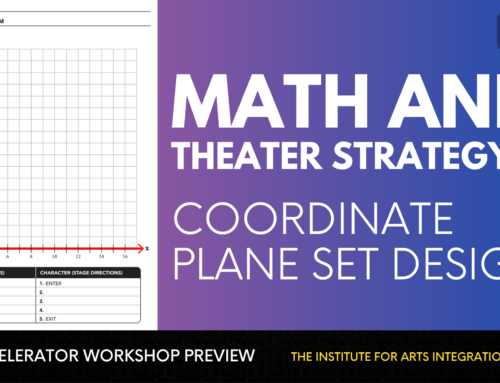Let’s explore how to connect across the curriculum in and through the arts. These ideas will help content stick and also give students opportunities to play with a variety of art forms in the process.
The Seed Idea
Let’s start with a single idea to make language come to life. Write a boring adjective at the bottom of the paint strip on the most boring color. Give each student a paint strip and they can use a thesaurus or a word wall to think of “more colorful” words for their strip. Hang all of their strips on the door and they can use those words to help make their writing colorful.
Now, let’s explore how to take that idea of color and extend it even further.
ART:
Have the students create the paint strip themselves and turn it into a lesson on intensity. Each student can start by choosing a favorite color. Next the student must choose whether to add black or white to the chosen color to change its value. Each time more white or black is added to the chosen color, another sample is added to the paint strip being created. Once the strips are dry, the students can then use them for the language arts connection of creating more colorful writing.
WRITING:
A general way to approach this connection is to list a bunch of “boring” adjectives like “nice” or “fun” and assign one to each student with the challenge of finding “more colorful” words with similar meanings. To make it a more personal exercise, you could have samples of each students’ writing and charge each child with finding a boring or overused word from his/her sample and then researching other words that could add some color and/or variety to that piece. This could extend to other parts of speech (verbs like “said” and “like” come to mind!). It would be so interesting to see what words the students identify from the writing samples as “boring” or “tired/overused” and then hear the conversations between students as they try to decide which words to place where on this hierarchy of colorfulness!
SOCIAL STUDIES:
Now that the students have grappled with colorful language and related that to intensity of color, this line of thinking can be extended to thinking about people and eras being described as colorful. I know that history always became more interesting to me when my teacher or an author tried to paint a more complete picture of a person or period in history by telling colorful details. What makes a person or time period more colorful? What about this person makes them colorful and memorable to you? This is also true, of course, of fictitious characters in literature. Ooo, another connection!
THEATER:
How do you make those colorful characters, real or fictitious, come alive on stage? How do you make the spoken word more colorful? Try reading a line to your students without expression. Then add an appropriate voice, then facial expression, then gesture and posture. This is a great lesson in the actor’s tools of voice and body to add color to her/his performance. Perhaps the character is not a colorful one and the lack of intensity is the character. How does exaggeration of delivery in voice and body to portray the intensity of a character in theater relate to adding black or white to change a color’s intensity in art?
MOVEMENT:
This theater connection relates so directly to dance or movement. Create a simple movement like bending one leg and reaching with one arm. By using that same idea of more or less exaggeration create a deeper or less deep bend in the leg or a longer or less long reach of the arm. How does that change the intensity of the color of the movement? Which version of the movement seemed more “colorful”? As students create movement to demonstrate other concepts you study in the future, this lesson can help them revise their choreography to make it more effective.
MUSIC:
Now the students are primed to explore “timbre” or color in music. Have them listen to Danny Kaye’s recording of the Hans Christian Andersen story “Tubby the Tuba.” In the recording, a melody is tossed around the orchestra played by violins, piccolos, cellos and finally by Tubby who is tired of playing “oom-pahs” and longs for a melody of his own. It’s a great way to hear how the timbre of the instruments change how the sound “looks” to the mind’s eye. Which instrument was the most colorful or had the greatest intensity? Why might a composer choose one instrument over another to play a melody?
SCIENCE:
That leads us to the science of color and sound. What is it that actually makes one instrument sound different from another? Why does the violin sound so different from a cello and create such a different color in the sound? And what is color anyway? This led me to looking for different websites that discuss the science of color for elementary, middle, and high school students.
Here are a few that I found to help you explore those questions with your students:
http://www.brainpop.com/science/energy/rainbows/preview.weml
http://www.mhschool.com/science/2000/student/5/review/summary/5-3-6-6.html
http://www.thetech.org/exhibits/online/color/intro/
http://hyperphysics.phy-astr.gsu.edu/hbase/vision/newtcol.html
I hope these ideas of connecting curriculum through the concept of intensity of color inspire you to find other ways to connect and integrate the arts in your teaching!






